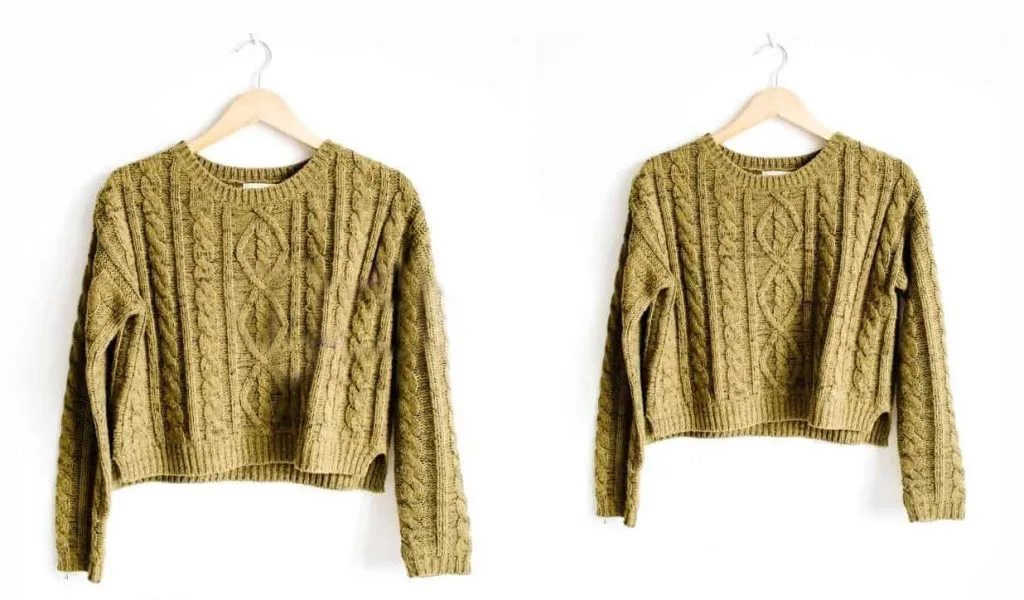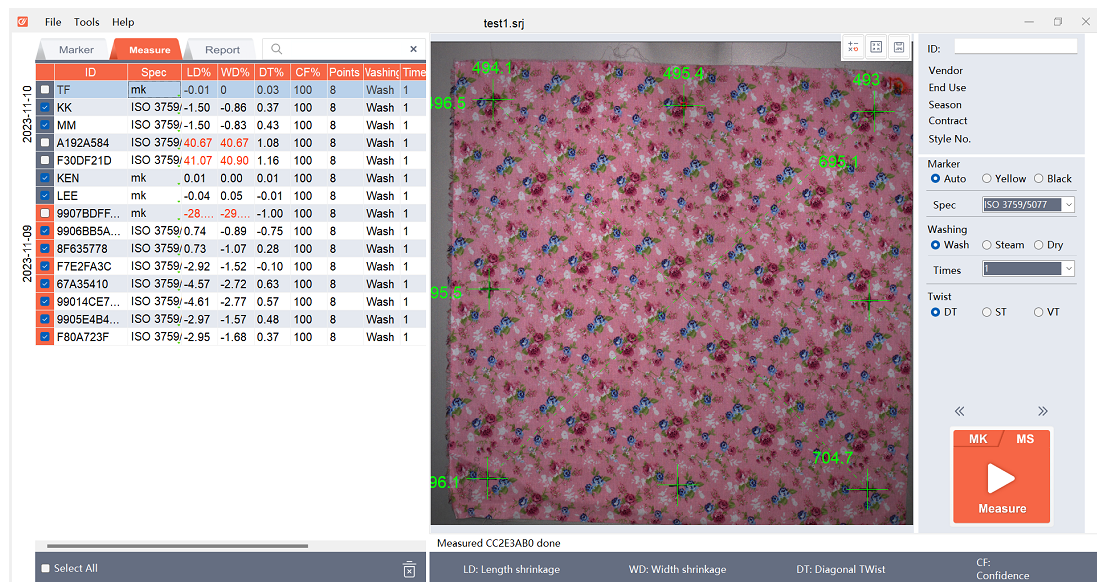The Significance of Fabric Dimensional Change
In the textile industry, understanding fabric shrinkage and dimensional change is critical to ensuring the quality and performance of fabrics. Whether it’s the shrinkage of fabric during washing, the effect of dry cleaning on size, or the alterations caused by steaming, these factors significantly influence consumer satisfaction and fabric usability. This article provides a detailed exploration of fabric shrinkage test methods, shrinkage rate calculations, and relevant standards, with a focus on maintaining the dimensional stability of fabric.
The fabric dimensional change rate is a key indicator of fabric wearability. It refers to the change in length or width of the fabric after undergoing various external processes, such as washing, dry cleaning, or steaming, while in a relaxed state. The extent of this dimensional change directly influences the fabric’s dimensional stability and, consequently, its wearability.

Dimensional Change to Washing
Dimensional change to washing refers to the alteration in length or width of a textile product following processes such as washing, dehydration, and drying under specific conditions. As people’s quality of life continues to improve, consumers are placing greater emphasis on the wearability of textile products. There are various indicators for evaluating wearability, and the stability of washing dimensions significantly impacts the appearance and functionality of these products. Consequently, dimensional change during washing has emerged as a key assessment criterion, and the potential for clothes to shrink or deform plays a crucial role in influencing consumers’ purchasing decisions.
The shrinkage rate of textiles often depends on the washing method used. Testing procedures align with globally recognized standards such as ISO 6330:2012 for home laundering and AATCC 135:2012 for dimensional change. During these tests, samples are treated with specific washing and drying cycles to evaluate the dimensional stability to washing. A “+” sign indicates elongation, while a “-” sign represents shrinkage.
Testing Standards on Dimensional Change to Washing
- “Preparation, Marking and Measurement of Fabric Specimens and Garments in the Test for Determining Dimensional Change of Textiles” (GB/T 8628 – 2013)
- “Home Laundering and Drying Procedures for Textile Testing” (GB/T 8629 – 2001)
- “Determination of Dimensional Change after Washing and Drying of Textiles” (GB/T 8630 – 2013)
- “Preparation, Marking and Measurement of Garment and Fabric Samples for the Test of Determining Dimensional Change of Textiles” (ISO 3759:2011)
- “Home Laundering and Drying Procedures for Textile Testing” (ISO 6330:2012)
- “Determination of Dimensional Change after Washing and Drying of Textiles” (ISO 5077:2007)
- “Determination of Dimensional Change after Domestic Laundering of Fabrics” (AATCC 135:2012)
These fabric shrinkage test standards ensure accuracy in determining the shrinkage percentage in textiles and their dimensional stability to washing.
The following is a detailed introduction with reference to these standards:
- “Preparation, Marking and Measurement of Fabric Specimens and Garments in the Test for Determining Dimensional Change of Textiles” (GB/T 8628 – 2013)
- “Home Laundering and Drying Procedures for Textile Testing” (GB/T 8629 – 2001)
- “Determination of Dimensional Change after Washing and Drying of Textiles” (GB/T 8630 – 2013)
Testing Principle
We carefully select representative samples and mark reference points on them. After we treat the specimens with our washing and drying procedures, we measure the distances between these reference points. From there, we can calculate the washing dimensional change rate. If we see a “+” sign, it means the specimen has elongated, while a “-” sign shows that it has shrunk. This process helps us understand how the materials respond to washing.

Testing Instrument
The requirements for ballast materials vary depending on the type of washing machine. There are three types of ballast materials for Type A washing machines and two types for Type B washing machines. The requirements for ballast materials are shown in Table 2 – 23.
Table 2-23: Dimensional Stability to Washing – Fabric Requirements
| Fabric Type | Pure Cotton Long Staple Knitted Fabric | Pure Cotton Plain Knitted Fabric | 50/50 Polyester/Cotton Plain Knitted Fabric | Pure Cotton Woven Fabric | 50/50 Polyester/Cotton Woven Fabric |
| Applicable Washing Machine | Single Drum Washer | Single Drum Washer | Single Drum Washer | Single Drum Washer | Single Drum Washer |
| Fabric Weight (g/m²) | 310 ± 20 | 155 ± 5 | 155 ± 5 | 92 ± 5 | 92 ± 5 |
| Fabric Thickness (mm) | 20 ± 4 | 20 ± 4 | 92 ± 5 | 92 ± 5 | 92 ± 5 |
| Fabric Count (threads/cm) | 50 ± 5 | — | — | 130 ± 10 | 130 ± 10 |
| Yarn Count (tex or Ne) | — | — | — | 37 × 1 | 18.6 × 2 |
| Fabric Density (threads/cm) | — | — | — | 210 × (190 ± 20) | 190 × (190 ± 20) |
Sample Preparation
For garment samples, please ensure they are undamaged and tested in their entirety. For fabric samples, first cut the specimen, then adhere to the corresponding fabric product standards or the guidelines outlined in GB/T 8628 – 2013. Each piece should measure at least 500mm × 500mm, with all sides aligned parallel to the fabric’s length and width. If the fabric width is less than 650mm, a full-width specimen may be used for testing with the agreement of the relevant parties. Additionally, if there is a risk of fraying at the fabric edge during testing, please overlock the specimen with stable stitching.
For small items like bras, knitted socks, hats, and gloves, determine the measurement positions based on the relevant product standards. If the standards do not specified, use the measurement methods outlined in Appendix B of GB/T 8628-2013, adding marking points to identify specific positions as needed.
If it is a fabric sample, measure and mark the sample before washing according to the requirements of the corresponding fabric product standard, or according to the provisions of GB/T 8628 – 2013, at least three pairs of marks should be made in the length and width directions of the specimen. The distance between each pair of marks should be at least 350mm, and the distance from the mark to the specimen edge should be not less than 50mm. The marks should be evenly distributed on the specimen.
Sample Marking and Measurement
Measurement of Sample Dimensions before Washing
Place the specimen flat on the measuring table, gently smooth out the wrinkles, and avoid twisting the specimen. Place the measuring ruler on the specimen and measure the distance between the two marked points. Record the measurement accurately to the nearest 1mm.
Washing Procedures
The washing procedures for Type A and Type B washing machines are as follows.
Table 2 – 24 Washing Procedure of Type A Washing Machine
| Procedure Number | Heating and Agitation | Total Load (Dry Mass) / kg | Washing | Washing | Washing | Washing | Rinse 1 | Rinse 1 | Rinse 1 | Rinse 2 | Rinse 2 | Rinse 2 | Rinse 3 | Rinse 3 | Rinse 3 | Rinse 4 | Rinse 4 | Rinse 4 | |
| Washing and Drying Quality | Water Level/cm | Washing Time/min | Cooling or not | Water Level/cm | Washing Time/min | Dehydration Time/min | Water Level/cm | Washing Time/min | Dehydration Time/min | Water Level/cm | Washing Time/min | Dehydration Time/min | Water Level/cm | Washing Time/min | Dehydration Time/min | ||||
| 1A | Normal | 2 ± 0.1 | 92 ± 3 | 10 | 15 | √ | 13 | 3 | 3 | 13 | 3 | – | 13 | 2 | – | 13 | – | 5 | |
| 2A | Normal | 2 ± 0.1 | 60 ± 3 | 10 | 15 | × | 13 | 3 | 3 | 13 | 3 | – | 13 | 2 | – | 13 | – | 5 | |
| 3A | Normal | 2 ± 0.1 | 60 ± 3 | 10 | 15 | × | 13 | 3 | 3 | 13 | 3 | – | 13 | 2 | 2 | – | – | – | |
| 4A | Normal | 2 ± 0.1 | 50 ± 3 | 10 | 15 | × | 13 | 3 | 3 | 13 | 3 | – | 13 | 2 | 2 | – | – | – | |
| 5A | Normal | 2 ± 0.1 | 40 ± 3 | 10 | 15 | × | 13 | 3 | 3 | 13 | 3 | – | 13 | 2 | – | 13 | 2 | 5 | |
| 6A | Normal | 2 ± 0.1 | 40 ± 3 | 10 | 15 | × | 13 | 3 | 3 | 13 | 3 | – | 13 | 2 | 2 | – | – | – | |
| 7A | Gentle | 2 ± 0.1 | 40 ± 3 | 13 | 3 | × | 13 | 3 | 3 | 13 | 3 | 1 | 13 | 2 | 6 | – | – | – | |
| 8A | Gentle | 2 ± 0.1 | 30 ± 3 | 13 | 3 | × | 13 | 3 | 3 | 13 | 3 | – | 13 | 2 | 2 | – | – | – | |
| 9A | Gentle | 2 | 92 ± 3 | 10 | 12 | √ | 13 | 3 | 3 | 13 | 3 | – | 13 | 2 | 2 | – | – | – | |
| Imitation Hand – wash | Gentle | 2 | 40 ± 3 | 13 | 1 | × | 13 | 2 | 2 | 13 | 2 | 2 | – | – | – | – | – | – |
Table 2 – 25 Washing Procedure of Type B Washing Machine
| Procedure Number | Agitation during Washing and Rinsing | Total Load (Dry Mass) / kg | Washing | Washing | Washing | Rinsing Water Level | Spin – drying |
| Temperature / °C | Water Level | Washing Time / min | |||||
| 1B | Normal | 2 ± 1 | 70 ± 3 | Full | 12 | Full | Normal |
| 2B | Normal | 2 ± 1 | 60 ± 3 | Full | 12 | Full | Normal |
| 3B | Normal | 2 ± 1 | 60 ± 3 | Full | 10 | Full | Gentle |
| 4B | Normal | 2 ± 1 | 50 ± 3 | Full | 12 | Full | Normal |
| 5B | Normal | 2 ± 1 | 50 ± 3 | Full | 10 | Full | Gentle |
| 6B | Normal | 2 ± 1 | 40 ± 3 | Full | 12 | Full | Normal |
| 7B | Normal | 2 ± 1 | 40 ± 3 | Full | 10 | Full | Gentle |
| 8B | Gentle | 2 ± 1 | 40 ± 3 | Full | 8 | Full | Gentle |
| 9B | Normal | 2 ± 1 | 30 ± 3 | Full | 12 | Full | Normal |
| 10B | Normal | 2 ± 1 | 30 ± 3 | Full | 10 | Full | Gentle |
| 11B | Gentle | 2 ± 1 | 30 ± 3 | Full | 8 | Full | Gentle |
Drying Procedure
Treatment before Measuring the Washed Sample
The conditioning treatment of the washed sample is the same as that before washing and can be carried out according to the specific requirements of the product standard or the agreement between the relevant parties. The conditioning atmosphere is in accordance with GB 6529, and the conditioning is carried out until a constant weight is reached.
Measurement of Washed Sample Dimensions
The measurement positions or marked points of the washed sample are the same as those before washing, and the measurement method is exactly the same. Calculate the dimensional change rates in the length and width directions and their respective averages.
Calculation of Results
Shrinkage Formula
The formula for calculating the shrinkage rate results according to Equations (2 – 18) and (2 – 19).

The average value of the dimensional change rate is rounded to 0.1%.
This formula is indispensable for creating a fabric shrinkage chart and conducting thorough fabric shrinkage tests.

Dimensional Change to Dry Cleaning
Dry cleaning, a preferred method for delicate fabrics, also affects the shrinkage of fabric. Standards like AATCC 158 guide the procedures for testing fabric dry-cleaning effects, ensuring the longevity of garments.
Dry cleaning is a process of using organic solvents to clean textile products, which can dissolve some oils, fats, and dispersed small dirt that cannot expand or cross – link with each other during the washing process or in a wet state. To better remove oil stains and dirt, a small amount of water and surfactant are added to the solvent. For some products that are sensitive to humidity, water is not added to the solvent, but a surfactant is added to make the dirt easier to remove and prevent the fabric from graying. Dry cleaning can use a variety of organic solvents, but tetrachloroethylene is commonly used in various countries.
Post-treatment is typically performed after dry cleaning and includes steam or hot pressing. Steam or hot pressing treatments can enhance the dry cleaning shrinkage rate. A single treatment can only bring a little improvement, and only after multiple treatments can there be a significant improvement. Usually, after 3 – 5 times of dry cleaning and finishing, the dimensional change of the fabric is more obvious.

Testing Standards
- “Testing Method for Dry Cleaning Resistance of Garments with Adhesive Interlining” (FZ/T 80007.3 – 2006)
- “Professional Care, Dry Cleaning and Wet Cleaning of Textiles – Part 2: Performance Test Procedure for Cleaning and Finishing with Tetrachloroethylene” (ISO 3571 – 2:1998)
- “Professional Care, Dry Cleaning and Wet Cleaning of Textiles – Part 3: Performance Test Procedure for Cleaning and Finishing with Hydrocarbon Solvents” (ISO 3571 – 3:1998)
- “Dimensional Change in Tetrachloroethylene Dry Cleaning: Machine Wash Method” (AATCC 158:2011)
The following is a detailed introduction with reference to these standards:
- “Dimensional Change in Tetrachloroethylene Dry Cleaning: Machine Wash Method” (AATCC 158 – 2011)
- “Professional Maintenance, Dry Cleaning and Wet Cleaning of Textiles – Part 2: Procedure for Performance Testing when Using Tetrachloroethylene for Dry Cleaning and Ironing” (GB/T 19981.2:2005)
Testing Principle
Mark and measure the length of the conditioned fabric or garment, then subject the sample to the dry cleaning process and post – treatment, and finally measure the dimensional change rate of the sample after conditioning.
Testing Instrument
- Dry Cleaning Machine: A closed-type commercial rotary cage dry cleaning machine that can use tetrachloroethylene solvent. The diameter of the rotary cage is not less than 600mm and not more than 1080mm, and the depth is not less than 300mm. It is equipped with 3 – 4 lifting blades. The rotation speed of the rotary cage is between 0.5 and 0.8 in terms of the coefficient g during dry cleaning and between 35 and 120 during liquid extraction. The machine must include a thermometer to measure the solvent’s temperature and a suitable device to enable the slow addition of the emulsion below the solvent level between the inner and outer cages. The dry cleaning machine can either be a washing-drying integrated unit or paired with a separate dryer. Regardless of the dryer type, it must include a temperature controller to regulate the air inlet or outlet temperature during drying. The size of the rotary cage of the dryer should be the same as that of the dry cleaning machine.
- Equipment for Sample Post-treatment
- Standard Testing Environment
- Ballast Materials for Washing Fabrics or Garments: White or light-colored, with a composition of 80% wool and 20% cotton or viscose.
- Marker Pen for Marking
- Measuring Ruler with a Minimum Scale of Millimeter
- Testing Platform: Capable of laying the sample flat for measurement.
Sample Preparation
- Place the samples separately on a flat and smooth horizontal surface and leave them in an environment with a temperature of (21 ± 1)°C and a relative humidity of (65 ± 2)% for not less than 24h.
- When marking, place the sample flat on a smooth table without tension, and avoid places with wrinkles or creases. Print three sets of marks in the length and width directions, and the mark size should be at least 250mm. If the sample is a garment, mark various parts of the garment, including the fabric and lining.

Testing Method
It is divided into general material testing and sensitive material testing. For specific operation steps, please refer to different fabric types and corresponding standards for testing.
Calculation of Results
Determine the rates of dimensional change in both the length and width of the fabric, as well as the key components of the garment. The results are averaged and accurate to 0.2%. A “-” sign indicates shortening and a “+” sign indicates elongation.
Dimensional Change to Steaming
Steaming is crucial in the finishing process, but it may lead to alterations in fabric dimensions. Dimensional change to steaming refers to the dimensional change of a textile product caused by ironing and other treatments without external tension.
The use of steaming equipment and proper testing ensures that fabrics retain their dimensional stability.

Testing Standards
The commonly used testing standards currently include: “Test Method for Dimensional Change of Fabrics after Steaming” (FZ/T 20021 – 2012); “Determination of Dimensional Change Rate of Wool Woven Fabrics after Steaming – Hoffman Method” (FZ/T 20023 – 2006).
The following is a detailed introduction taking “Determination of Dimensional Change Rate of Wool Woven Fabrics after Steaming – Hoffman Method” (FZ/T 20023 – 2006) as an example.
Testing Principle
Steam the textile specimen on a flat steam pressing machine in a freely movable state and measure its dimensional change.
Testing Equipment
A flat steam pressing machine (Hoffman type). The pressing machine sprays steam from a flat plate positioned 9–11 mm away from the specimen without directly contacting it. Use saturated steam at a temperature of 156–160°C.
Sample Preparation
- Cut the specimen to a size of 600 mm × 600 mm, ensuring it is taken 50 mm away from the fabric edge and free from any defects.
- Make 3 pairs of marks in both the warp and weft directions on the specimen, with a distance of 500mm between each pair of marks and a distance of 250mm between every two pairs of marks in the warp and weft directions.
Note: Do not use a marker pen for marking to avoid the influence of pigment on later measurement.
Standard Atmosphere
Conditioning and Testing Standard Atmosphere: Temperature 18 – 22°C; relative humidity 62% – 68%.
Pre – conditioning Atmosphere: Temperature not exceeding 50°C; relative humidity 10% – 25%.
Testing Procedures
- Pre-condition the specimen for 2h as required.
- Mark the specimen with needles and threads.
- Condition and balance the specimen in the standard atmosphere for 24 hours.
- Measure the distance L₁ between each pair of marks in the warp and weft directions, accurate to 0.5mm.
- Place the sample flat on the bottom plate of the steam pressing machine without any tension and lower the cover plate.
- Steam the specimen for 10 seconds.
- Vacuum the bottom plate for 10 seconds.
- Lift the cover plate take out the specimen and gently shake it.
- Flip the specimen and repeat steps 4 – 7 four times (a total of 5 times).
- Pre-condition the steamed sample for 2h again.
- Place the re – pre-conditioned sample in the standard atmosphere for conditioning and balance for 24h.
- Measure the distance L₂ between each pair of marks in the warp and weft directions, accurate to 0.5mm.
Calculation of Result
Calculate the dimensional change rates in the warp and weft directions respectively according to Equation (2 – 25) and round to one decimal place.

where S is the dimensional change rate; L₁ is the original dimension; L₂ is the dimension after steaming.
SmartShrink Shrinkage Rate Tester
The SmartShrink shrinkage rate tester efficiently measures various shrinkage data of fabrics after washing, steaming, and dry cleaning in just 5 seconds. It represents a significant advancement in textile shrinkage analysis, delivering dependable results for manufacturers and researchers.
Utilizing a self-developed visual algorithm, the device automatically captures images and collects warp and weft data for shrinkage rate tests before and after treatment. It measures the distance between marked points to automatically calculate the shrinkage rate and generates corresponding data records within the software. Scanning the QR code on the textile generates and saves the relevant data, significantly boosting efficiency in shrinkage rate testing for textile factories, minimizing manual errors, and ensuring precise, reliable results. For more information on parameters, please refer to this page.
Conclusion
In conclusion, the accurate assessment of fabric dimensional change is essential for ensuring the quality and performance of textile products. The detailed standards and procedures for washing, dry cleaning, and steaming dimensional change tests provide a solid framework for manufacturers, retailers, and consumers to understand and manage these changes.
The SmartShrink shrinkage rate tester further revolutionizes the process, offering a fast and reliable solution for obtaining precise shrinkage rate data. By adhering to these testing and analysis techniques, the textile industry can continue to deliver high quality products that meet the expectations of consumers in terms of fit, appearance, and durability.
For any textile-related questions or advanced testing solutions, reach out to experts who can guide you through every step of achieving the best shrinkage test results.
Email: sales@chivention.com
WhatsApp: +86 180 2511 4082

